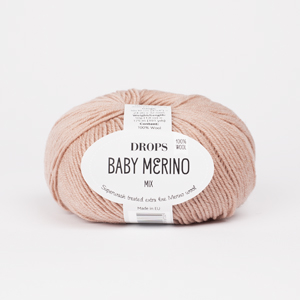Comments / Questions (41)
![]() Lianne wrote:
Lianne wrote:
Aahh natuurlijk, afwisselend RE en AV omdat je rond breit ;)
27.06.2025 - 20:37
![]() Lianne wrote:
Lianne wrote:
Ribbelsteek is toch alle naalden recht breien?
27.06.2025 - 15:24
![]() Leen wrote:
Leen wrote:
Hallo, ik zou graag deze muts voor een pasgeborene maken maar ik heb even een vraagje bij de uitleg: bij het minderen van 8st gelijkmatig betekend dit dat je 8 steken op eenzelfde naald moet minderen? Alvast bedankt.
01.11.2024 - 14:47DROPS Design answered:
Dag Leen,
Ja klopt. Je meerdert in totaal 8 steken over 1 naald en je verdeeld dit gelijkmatig over de naald.
03.11.2024 - 11:42
![]() Massar Omar wrote:
Massar Omar wrote:
Hej Billedet ser ud til at være strikket i retstrik ( ret, ret) men i opskriften indebærer også vrang strik. Hvordan skal det forståes? På forhånd tak.
30.03.2024 - 22:21
![]() Nele Bracke wrote:
Nele Bracke wrote:
Hallo, Op de foto lijkt het kindje op een bijpassend dekentje te liggen. Waar kan ik het patroon van dit dekentje vinden? Alvast bedankt.
27.03.2022 - 14:24DROPS Design answered:
Dag Nele,
Waarschijnlijk is dit het dekentje dat gebruikt is in de foto. Het komt uit hetzelfde boek.
29.03.2022 - 09:47
![]() Enrica wrote:
Enrica wrote:
Posso lavorare con i ferri circolari n 3 e com'è il procedimento ? Grazie
10.02.2022 - 13:35DROPS Design answered:
Buomasera Enrica, può utilizzare i ferri circolari con cavo corto oppure con il cavo lungo utilizzando la tecnica del magic loop. Buon lavoro!
10.02.2022 - 16:22
![]() Nelly wrote:
Nelly wrote:
Quelle hauteur totale mesure le bonnet pour la taille 6/9 mois svp
24.08.2021 - 21:36DROPS Design answered:
Bonjour Nelly, si votre tension est juste en hauteur, le bonnet va mesurer environ 17 cm de hauteur totale (y compris les 6 cm du revers). Bon tricot!
25.08.2021 - 07:25
![]() Sharon Coull wrote:
Sharon Coull wrote:
I am stuck with this pattern. It says the pattern is garter stitch, but then it says knit a row and then purl next row, which is stocking stitch. Is this pattern available to knit flat?
08.05.2021 - 22:29DROPS Design answered:
Dear Sharon, the piece is knitted on the round, so to get a garter stitch you need to knit a round then purl a round, etc. Happy Knitting!
08.05.2021 - 22:44
![]() Sara wrote:
Sara wrote:
Bonjour,\r\nEst il possible de le tricoter en aiguille circulaire en suivant les même recommandations ?
28.04.2021 - 20:52
![]() Ghada Gamil wrote:
Ghada Gamil wrote:
What do you mean by k all sts tog 2 by 2 Thanks
04.04.2021 - 16:16DROPS Design answered:
Dear Ghada Gamil, it means that you do k2tog all the way through the row 7 round. Happy Knitting!
04.04.2021 - 21:23
Peek-a-boo#peekaboohat |
|
|
|
|
Knitted baby hat in garter st in DROPS BabyMerino. Size premature - 4 years
DROPS Baby 25-10 |
|
|
GARTER ST (in the round on circular needle): * K 1 round and P 1 round *, repeat from *-*. 1 ridge = 2 rounds. ---------------------------------------------------------- HAT: Worked in the round on double pointed needles. Loosely cast on (68) 80-92-96-104 (112-116) sts on double pointed needles size 2 mm with Baby Merino. Work in GARTER ST - see explanation above - in the round on double pointed needles until piece measures (4) 4-6-6-6 (8-8) cm = edge. On next round with K, switch to needles size 3 mm and dec 8 sts evenly = (60) 72-84-88-96 (104-108) sts. Continue in garter st until piece measures (10) 11-12.5-12.5-14.5 (15-16) cm – adjust so that next round is a round with K and dec (6) 8-7-8-8 (8-9) sts evenly. Repeat dec every other round (i.e. every K round) (5) 5-5-5-5 (6-6) more times (= (6) 6-6-6-6 (7-7) dec rounds) = (24) 24-42-40-48 (48-45) sts. On next round K all sts tog 2 by 2. P 1 round and repeat dec on next K round in size 1/3, 6/9 and 12/18 months and (2-3/4) years (do not dec in the other sizes) = (12) 12-11-10-12 (12-12) sts. Pull a double yarn through the remaining sts, tighten tog and fasten. Fold the edge in the middle upwards so that it lies flat, fasten it with a couple of small stitches. |
|
Have you finished this pattern?Tag your pictures with #dropspattern #peekaboohat or submit them to the #dropsfan gallery. Do you need help with this pattern?You'll find 10 tutorial videos, a Comments/Questions area and more by visiting the pattern on garnstudio.com. © 1982-2025 DROPS Design A/S. We reserve all rights. This document, including all its sub-sections, has copyrights. Read more about what you can do with our patterns at the bottom of each pattern on our site. |











































Post a comment to pattern DROPS Baby 25-10
We would love to hear what you have to say about this pattern!
If you want to leave a question, please make sure you select the correct category in the form below, to speed up the answering process. Required fields are marked *.